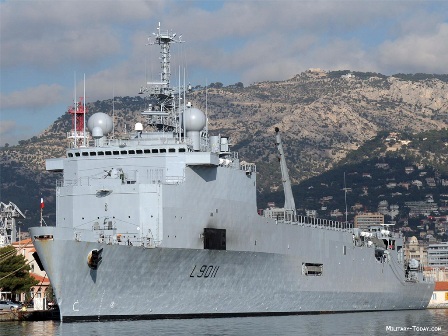Foudre-class
Summary
| Origin country | 🇫🇷 France |
| Category | Amphibious vessel |
| Subtype | Landing craft transport |
| Manufacturer | DCN, Brest |
| Year commissioned | 1990 |
| Units | L9011 FOUDRE, L9012 SIROCCO |
| Current operators | 🇧🇷 Brazil |
Description
The Foudre-class landing platform dock is a series of French naval vessels designed for deploying and supporting a mechanized regiment to remote locations. These ships serve as a logistic support system, offering crucial capabilities for amphibious operations. The class was devised to supplant the aging Ouragan class vessels, with an initial plan to build four ships. Ultimately, only two were produced—Foudre and Siroco.
Foudre-class ships were designed to carry and establish a mechanized regiment of the Rapid Action Force, providing it with a strategic logistics base once deployed. It could also accommodate additional troops and operated as a critical asset during amphibious maneuvers.
Initially conceived as replacements for the Ouragan class, the Foudre class offered several enhancements, boasting higher speeds, helicopter hangars, elevators for rapid cargo transfer, and dockside loading features. Despite plans to construct four ships, budget constraints led to a reduction in numbers, with the last two being recontracted as Mistral-class amphibious assault ships. The Foudre class excelled in amphibious capabilities with significant storage spaces, a well deck capable of accommodating various landing crafts, and quick ballasting systems for launching vessels. They provided temporary quarters for an extensive number of troops, had considerable cargo and vehicle capacity, and contained a fully functioning hospital area for medical emergencies.
Reflecting advancements over previous classes, the ships integrated an elevator to expedite cargo movement, a side ramp for easy loading, and controllable pitch propellers for propulsion. They achieved a top speed of 21 knots and carried sizable generators for electrical power, aside from featuring protected citadels against nuclear, biological, and chemical threats. Both ships featured a flight deck and a hangar, with the capacity to accommodate multiple helicopters. This aviation capacity was essential for their multirole operations, which ranged from troop deployment to medical evacuation.
The Foudre and Siroco served the French Navy from 1990 to 2014. During their service, they participated in various missions, including humanitarian relief. Foudre was decommissioned in 2011, while Siroco ended its French Navy service in 2015.
After being replaced by the Mistral class in the French Navy, Foudre was sold to the Chilean Navy in 2011 and renamed Sargento Aldea. Siroco followed suit, being sold to the Brazilian Navy in 2015 and rechristened Bahia.
Technical specifications
| Displacement | 12000 tons |
| Range | 20000 km at 15 knots |
| Endurance | 30 days |
| Crew | 215 members |
| Width | 23.5 m (77.1 ft) |
| Length | 168.0 m (551.2 ft) |
| Propulsion | 2 SEMT Pielstick 16 PC2 5 diesel engines with a power of 20,800 hp - 2 propellers |
| Thrust | 4250 hp |
| Armament | 3 Simbad (II 3) + 3 30mm Breda-Mauser guns + 4 12.7mm machine guns |
| Maximum speed | 21 knots |
